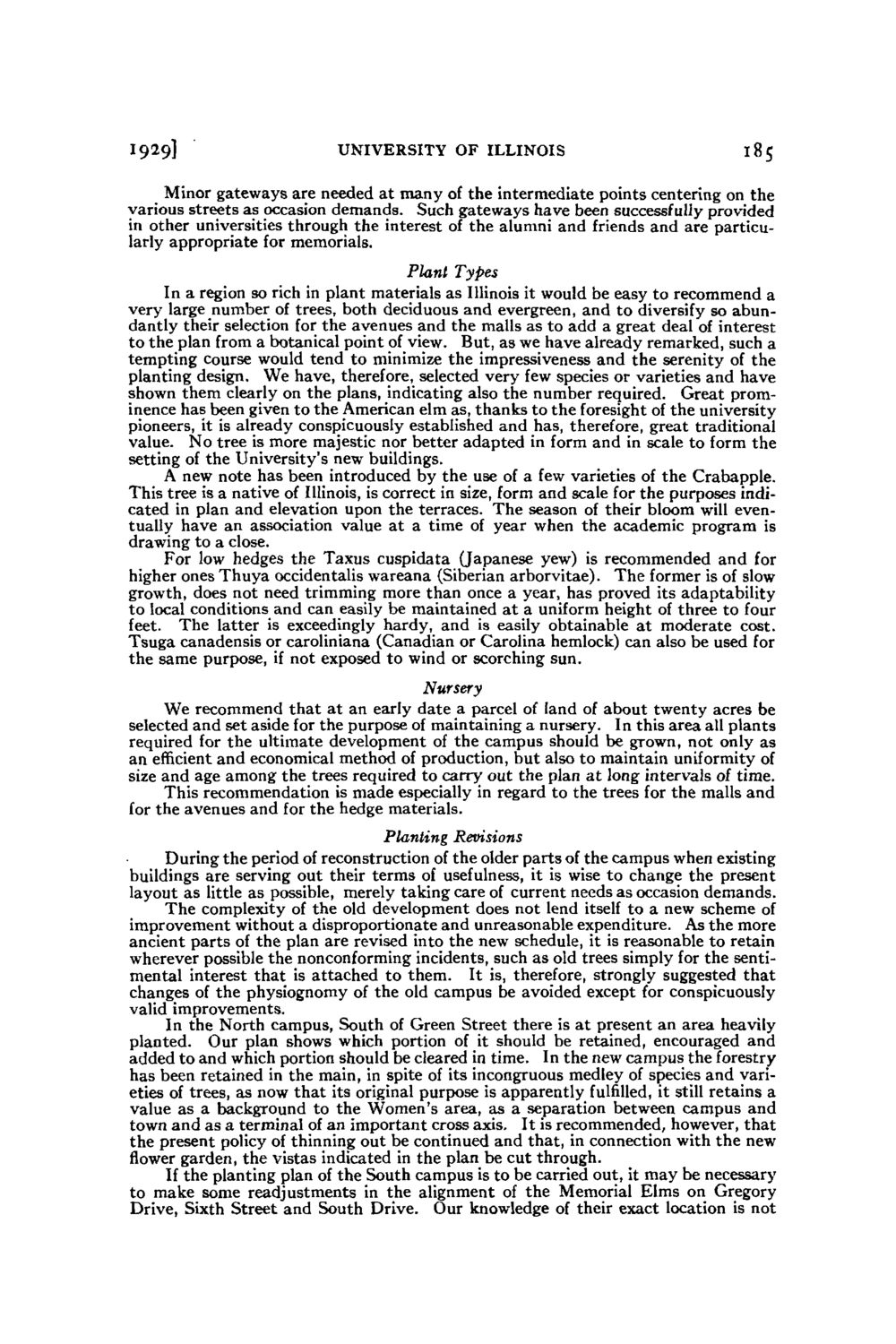| |
| |
Caption: Board of Trustees Minutes - 1930
This is a reduced-resolution page image for fast online browsing.

EXTRACTED TEXT FROM PAGE:
1929] U N I V E R S I T Y O F ILLINOIS 185 Minor gateways are needed at m a n y of the intermediate points centering on the various streets as occasion demands. Such gateways have been successfully provided in other universities through the interest of the alumni and friends and are particularly appropriate for memorials. Plant Types In a region so rich in plant materials as Illinois it would be easy to recommend a very large number of trees, both deciduous and evergreen, and to diversify so abundantly their selection for the avenues and the malls as to add a great deal of interest to the plan from a botanical point of view. But, as w e have already remarked, such a tempting course would tend to minimize the impressiveness and the serenity of the planting design. W e have, therefore, selected very few species or varieties and have shown them clearly on the plans, indicating also the number required. Great prominence has been given to the American elm as, thanks to the foresight of the university pioneers, it is already conspicuously established and has, therefore, great traditional value. N o tree is more majestic nor better adapted in form and in scale to form the setting of the University's new buildings. A new note has been introduced by the use of a few varieties of the Crabapple. This tree is a native of Illinois, is correct in size, form and scale for the purposes indicated in plan and elevation upon the terraces. The season of their bloom will eventually have an association value at a time of year when the academic program is drawing to a close. For low hedges the Taxus cuspidata (Japanese yew) is recommended and for higher ones Thuya occidentalis wareana (Siberian arborvitae). T h e former is of slow growth, does not need trimming more than once a year, has proved its adaptability to local conditions and can easily be maintained at a uniform height of three to four feet. The latter is exceedingly hardy, and is easily obtainable at moderate cost. Tsuga canadensis or caroliniana (Canadian or Carolina hemlock) can also be used for the same purpose, if not exposed to wind or scorching sun. Nursery W e recommend that at an early date a parcel of land of about twenty acres be selected and set aside for the purpose of maintaining a nursery. In this area all plants required for the ultimate development of the campus should be grown, not only as an efficient and economical method of production, but also to maintain uniformity of size and age among the trees required to carry out the plan at long intervals of time. This recommendation is m a d e especially in regard to the trees for the malls and for the avenues and for the hedge materials. Planting Revisions During the period of reconstruction of the older parts of the campus when existing buildings are serving out their terms of usefulness, it is wise to change the present layout as little as possible, merely taking care of current needs as occasion demands. The complexity of the old development does not lend itself to a new scheme of improvement without a disproportionate and unreasonable expenditure. As the more ancient parts of the plan are revised into the new schedule, it is reasonable to retain wherever possible the nonconforming incidents, such as old trees simply for the sentimental interest that is attached to them. It is, therefore, strongly suggested that changes of the physiognomy of the old campus be avoided except for conspicuously valid improvements. In the North campus, South of Green Street there is at present an area heavily planted. Our plan shows which portion of it should be retained, encouraged and added to and which portion should be cleared in time. In the new campus the forestry has been retained in the main, in spite of its incongruous medley of species and varieties of trees, as n o w that its original purpose is apparently fulfilled, it still retains a value as a background to the Women's area, as a separation between campus and town and as a terminal of an important cross axis. It is recommended, however, that the present policy of thinning out be continued and that, in connection with the new to m a k Sixth Street vistas indicated inalignment to be through. exact a yon Gregory flower e some readjustments in the campus isbe cutcarried out, it mlocation is not Drive, the planting and South South the plan of the of their Elms be necessary If garden, the plan of the Drive. Our knowledge Memorial
| |